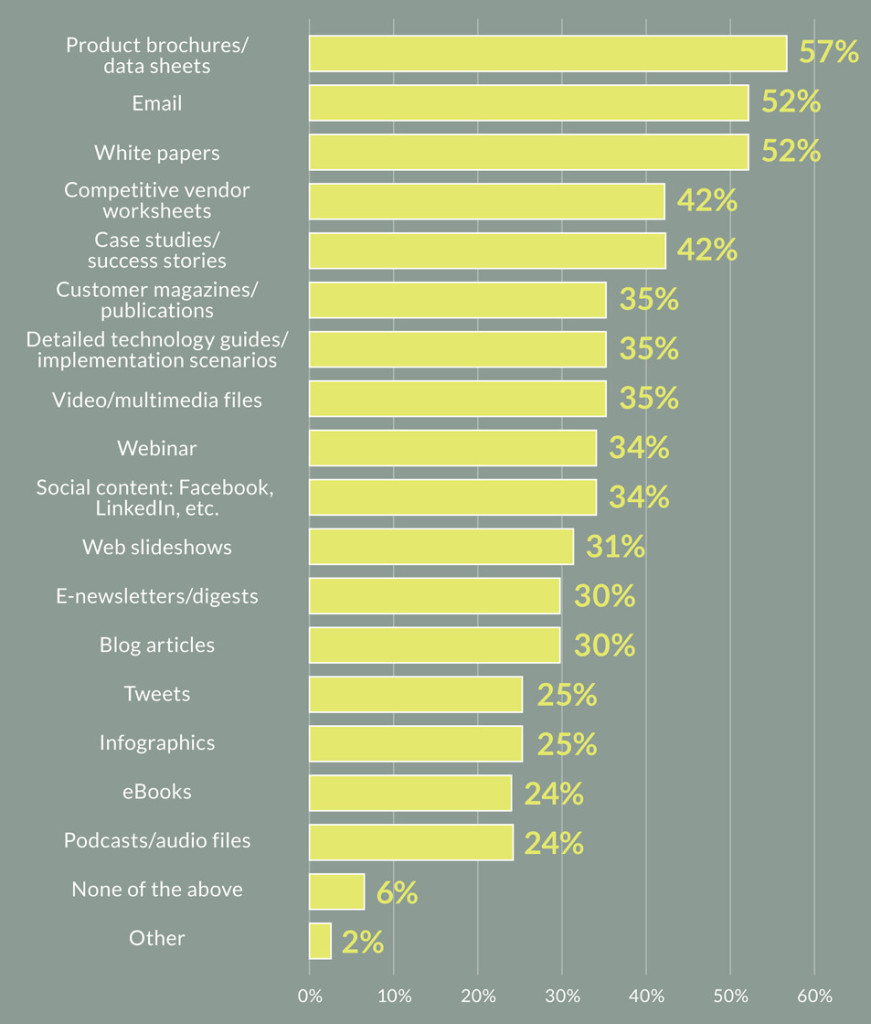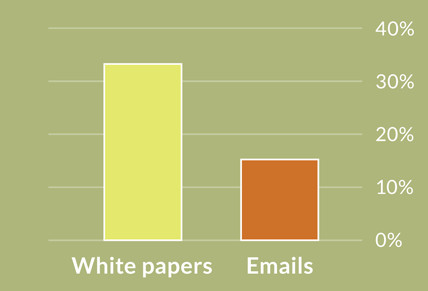It’s no secret: B2B decision makers have to slog through a lot of information. They need to be on the cutting edge of their industry yet still be adaptable enough to shift as the market’s demands and interests change.
Just getting to the key decision makers is an uphill climb, to be sure, but what if there were a shortcut?
A path you could carve, away from all the “me too” businesses and services aiming for a piece of that company’s profit pie – and still end up at the top?
Wouldn’t you want to know how?
The answer is all in the content.
But it’s not how much of it you produce that matters – it’s what you produce.
And these are the types of content that gets them to move ahead with a purchase.
How Much Content Do They Need to Make a Decision?
The recently revealed Eccolo Media B2B Technology Content Survey Report published by Eccolo Inc., pulls back the curtain on the buying habits of B2B technology decision makers. For example, they found that, on average, nearly half of those surveyed reported consuming only 2-5 collateral assets before making a decision.
Key B2B decision makers only need to consume as few as 2 pieces of collateral before deciding
That means if you’re pumping out lots of content in an attempt to sway them, you may be simply spinning your wheels in the mud. Instead, concentrate on creating less content, but making the content you do create better quality. Don’t just show why your service is a great deal or why your offer is irresistible – show the kinds of results it produces. Show how it performs “in the field.” Go the extra mile and do the research legwork that your competitors are unable, or unwilling to do.
What Kinds of Content Help Propel Their Decision?
Over half of respondents to the study reported reading an equal amount of emails and white papers. But when it came to influencing their decision, white papers were the clear leader:
White papers were more often used as an influence tool than emails
Before you set your staff to churning out white papers, keep in mind that it’s not that simple (it never is!) The study also went into detail on what types of content was consumed across 6 months to lead to a purchase. The results are pretty surprising:

Different types of content have varying degrees of success spurring B2B buyers on their decision
So What Can We Learn from This Information?
There are a few gold nuggets we can glean from the overall buying process of B2B decision makers. But what can we do with our existing content that will put the odds in our favor? Here are a few points to help:
Create a True Apples-to-Apples Comparison Chart
Having product/data sheets is all well and good, but notice that competitor vendor worksheets are also in the mix. Why run the risk of losing a decision-maker’s efforts when you can create your own comparison chart between your B2B service and those of your competitors? The more you can decrease the odds of them having to go offsite to see how your offer compares to others, the more likely you are to keep them engaged on what you do differently – and better.
Make Your Product Data Sheet Enticing
What’s more, a product/data sheet doesn’t have to be some boring overview. Make your best content work for you by bolding key phrases and benefits to stand out. Formulate your headers as questions to create a FAQ-style Q&A.
Make liberal use of bullet points to summarize key features, but include a link where more detailed information can be found. If someone read each of your bullet points and nothing else, would they understand the product enough to be able to make a confident buying decision about it?
Look at your product sheet not as data drivel, but as a way to address the B2B buyer’s key pain points. You have to know what they’re going through in order to present a solution that fits their needs. Talk about features, obviously, but don’t forget to include the benefits of those features in a way that makes sense from the buyer’s perspective.
Writing White Papers that Position You as the Authority
When was the last time you read a white paper that really stood out to you – like “These guys know what they’re talking about!” Never, right? First, don’t call it a white paper. It sounds boring and clichéd. Like a giant sales pitch – which is how many white papers are written. Remember, these are people who are actively looking for a solution. So present your paper in such a way as to address all of their concerns in a way that’s easy to read and understand.
You may want to re-brand it as a “Special” or “Insider” report. Take the time to answer the most common questions and back up your statements with clear, comprehensive proof. This is where the real meat and potatoes of your benefits comes in. Lay out precisely how the decision maker, their team, their company and their customers will benefit from your solution.
Think of your white paper not as a sales vehicle, but as a friendly guide – gently moving the decision maker down through each stage of your funnel in a way that doesn’t feel like a pitch, but more of a mutual understanding. You want the reader to come away with a deeper, fulfilled and complete picture of your solution and how it ties in with their existing needs.
Don’t Forget Your After-the-Sale Content
Oftentimes when closing a client, you’ve poured all your efforts into making their decision as easy and hassle-free as possible. Once they’re all set up and acquainted with your solution – don’t let them simply dry up and wither on the customer vine!
This is the prime time to follow up with upgrades or details on how they can get the most out of your product or service, as well as how to use it to build their business, retain their customers or experience growth faster or more fluidly than before. Remember that no one wants to feel like they’ve been duped or made a fool of. And if communication dries up after the sale, that’s precisely how they’ll feel.
By taking the time to not only write the kind of content that compels them to decide, but walk them through the process and guide them through each step – you’re showing these key decision makers that you’re not “all about the sale”, but rather all about the journey they’re taking to create a better experience for their own customers. And that’s the kind of journey you should take – together.
Do You Sell to B2B Companies?
What have your experiences been with using emails, white papers and data sheets as content to help spur their choice? Have you had different results than those reported on the surveys? Finding that a different method works better? Tell us about it in the comments below and share your story!
About the Author: Sherice Jacob helps business owners improve website design and increase conversion rates through compelling copywriting, user-friendly design and smart analytics analysis. Learn more at iElectrify.com and download your free web copy tune-up and conversion checklist today!

